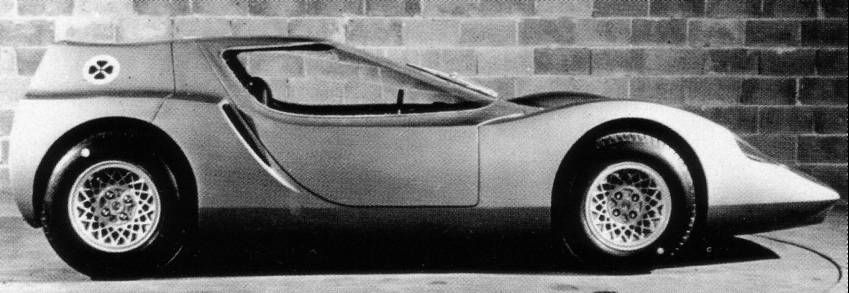O.S.I. (Officine Stampaggi Industriali) "Scarabeo" (Alfa Romeo 1600 GTA). Designed for low-volume production, the Giulia Scarabeo emerged first in 1966. With competition in mind, it used a transverse Giulia G.T.A. 1570cc engine (DOHC 4-cyl with 115bhp @ 6,00rpm) mounted behind the two seats. The rear wheels were driven through an angled shaft, the rear suspension used transverse arms with coilover units, and the disc brakes were inboard. The front suspension used a similar independent system and disc brakes, though outboard. Steering was rack and pinion while the fuel was stored in the large diameter tubes, which formed parts of the chassis structure. The body was made of a composite plastic fitted to a welded tubular and plate chassis which gave a weight of 700kg. The wheelbase was 2150mm (front/rear tracks: 1310mm/1320mm), while the total height was only 1020mm.
A total of three cars were built, two coupes (the first with right-hand drive, the second with left-hand drive) and a single spider version. The second coupe can be seen in the Alfa Romeo Museo at Arese.
It might have had its chances for production snatched away in favor of other projects. Still, the Alfa Romeo Scarabeo was so innovative that it gave the legendary Tipo 33 racing car some of its pioneering features.
Project Scarabeo came about in the mid-1960s when Alfa Romeo was developing a racing prototype to return to major competition following its withdrawal in 1953. Thanks to an improved financial position resulting from the sales success of the Giulietta in its various forms, the company had the means to continue from where the development of the stillborn Tipo 160 Grand Prix prototype of 1954 had left off.
The racing prototype sat on an H-shaped chassis, three of which were sent – along with a Giulia G.T.A. engine – to O.S.I. of Turin, a subsidiary of Ghia. Each chassis was given different bodywork and a slightly different seating position; one of the principles that the Scarabeo explored was to have the driver seated as far back in the car as possible. It was intended to give the driver a better position to assess the behavior of – and thus control – the car. The idea had been suggested in the fifties by works driver Consalvo Sanesi.
The Scarabeo with seats furthest back was the silver coupé that debuted at the 1966 Paris Motor Show – also note the different bodywork from the yellow car. A third spider version was built as a test mule (thought to have used the same chassis of the racing prototype), and its bodywork was never completed. Unlike its siblings, the silver coupé was built with right-hand drive, necessitated by positioning the rear-mounted engine’s carburetors. They were located just behind the seat's headrest on the left-hand side of the car, with the occupant only protected from deafness by a thin sheet of Perspex.
A novel approach to chassis design was incorporated into the Scarabeo. The H-shaped structure was fabricated from large-diameter tubes, including the fuel tanks, to spread the liquid’s weight evenly across the car. This concept was used later in Tipo 33, as was Scarabeo’s employment of exotic materials such as magnesium. Other interesting features included a clutch and gearbox incorporated into the engine block; drive to the differential was also an integral unit. The rear disc brakes were centrally, and each corner was sprung independently.
Although the Scarabeo concept’s mechanical elements were advanced enough to be used in the prestigious Tipo 33, it seemed there was not a good enough business case to conclude its development with a small production run, as was initially intended. Of the three Scarabeos built, two remain in Alfa’s collezione storica, while the silver coupé escaped and is thought to be in a private collection in Canada.
Source: www.carsfromitaly.net; Joe Breeze - www.classicdriver.com
Images: www.karmannghia.it; www.conceptcars.it; Alfa Romeo Automobilismo Storico, Centro Documentazione (Arese, Milano)
%20(4)_edited.png)




































